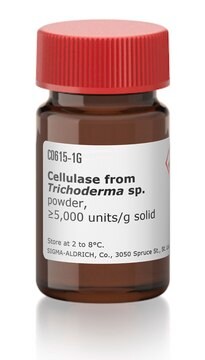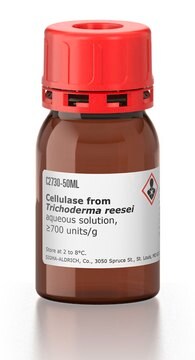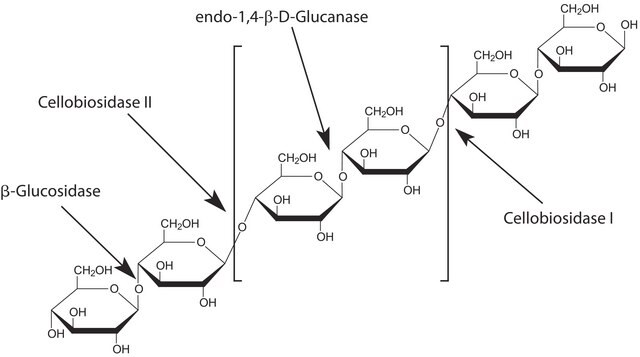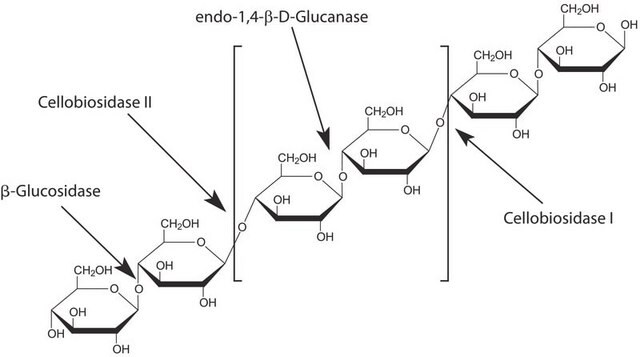C1794
Cellulase from Trichoderma sp.
BioReagent, suitable for plant cell culture, 3-10 units/mg solid
Synonym(s):
β-1,4-glucanase
Sign Into View Organizational & Contract Pricing
All Photos(3)
About This Item
Recommended Products
biological source
fungus (Trichoderma sp.)
Quality Level
product line
BioReagent
form
powder
specific activity
3-10 units/mg solid
contains
maltodextrin
greener alternative product characteristics
Design for Energy Efficiency
Learn more about the Principles of Green Chemistry.
sustainability
Greener Alternative Product
technique(s)
cell culture | plant: suitable
application(s)
agriculture
greener alternative category
, Enabling
storage temp.
2-8°C
Looking for similar products? Visit Product Comparison Guide
General description
We are committed to bringing you Greener Alternative Products, which adhere to one or more of The 12 Principles of Greener Chemistry. This product has been used as enzyme for alternative energy. For more information see the Enzymes for Alternative Energy Research.
Application
Cellulase (β-1,4-glucanase) is a natural enzyme produced by the filamentous fungi Trichoderma viride which promotes the endohydrolysis of (1→4)-beta-D-glucosidic linkages in cellulose and lichenin. Cellulases are important for processing potential commercial products such as cellulosic ethanol.
Unit Definition
One unit will liberate 1.0 μmole of glucose from cellulose in one hour at pH 5.0 at 37 °C (2 hr incubation time).
substrate
Product No.
Description
Pricing
Signal Word
Danger
Hazard Statements
Precautionary Statements
Hazard Classifications
Resp. Sens. 1
Storage Class Code
11 - Combustible Solids
WGK
WGK 1
Flash Point(F)
Not applicable
Flash Point(C)
Not applicable
Personal Protective Equipment
dust mask type N95 (US), Eyeshields, Gloves
Choose from one of the most recent versions:
Already Own This Product?
Find documentation for the products that you have recently purchased in the Document Library.
Customers Also Viewed
Mari Aidemark et al.
BMC plant biology, 10, 274-274 (2010-12-16)
Alamethicin is a membrane-active peptide isolated from the beneficial root-colonising fungus Trichoderma viride. This peptide can insert into membranes to form voltage-dependent pores. We have previously shown that alamethicin efficiently permeabilises the plasma membrane, mitochondria and plastids of cultured plant
Rachel A Levin et al.
The Journal of eukaryotic microbiology, 64(5), 588-597 (2017-01-26)
Dinoflagellates within the genus Symbiodinium are photosymbionts of many tropical reef invertebrates, including corals, making them central to the health of coral reefs. Symbiodinium have therefore gained significant research attention, though studies have been constrained by technical limitations. In particular
Binay Bhushan Panda et al.
BMC plant biology, 18(1), 89-89 (2018-05-23)
Poor filling of grains in the basal spikelets of large size panicles bearing numerous spikelets has been a major limitation in attempts to increase the rice production to feed the world's increasing population. Considering that biotechnological intervention could play important
Jin Zhou et al.
Bioresource technology, 100(2), 819-825 (2008-09-06)
To improve the enzymatic hydrolytic efficiency and reduce production cost, a statistically designed experimental approach was used to optimize the composition of cellulase mixture so as to maximize the amount of glucose produced from steam-exploded corn stover (SECS). Using seven
The genetic intractability of Symbiodinium microadriaticum to standard algal transformation methods.
Jit Ern Chen et al.
PloS one, 14(2), e0211936-e0211936 (2019-02-20)
Modern transformation and genome editing techniques have shown great success across a broad variety of organisms. However, no study of successfully applied genome editing has been reported in a dinoflagellate despite the first genetic transformation of Symbiodinium being published about
Our team of scientists has experience in all areas of research including Life Science, Material Science, Chemical Synthesis, Chromatography, Analytical and many others.
Contact Technical Service








